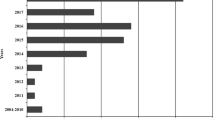Abstract
The results of measurements of the isotopic atomic ratios238Pu/239Pu,240Pu/239Pu,241Pu/239Pu,242Pu/239Pu in samples of bottom deposits are presented. The role of the main sources of plutonium contamination of the region is examined. It is shown that the contribution of the α activity of industrial plutonium (238–240Pu) in bottom sediments from the European reprocessing plants, mainly, Sellafield (Great Britain), on the background due to global fallouts is 20 to 55% of the total α activity and 70–95% for the β activity (241Pu). No escape of reactor and weapons plutonium from the nuclear powered submarine “Komsomolets” into the environment was observed. The lower limit of sensitivity of the method is 10−14g of plutonium in a sample, which corresponds to a plutonium α activity of 0.02 mBq in a 10 g sample of bottom deposits, 4 tables, 26 references.
Similar content being viewed by others
References
A. M. Sagalevich, “Technical means and methods of investigation,” in:Oceanological Investigations and Underwater-Technical Operations at the Location of Sinking of the Nuclear Powered Submarine “Komsomolets” [in Russian], Nauka, Moscow (1996), pp. 8–17.
V. S. Kyz'yurov, A. I. Laikin, Yu. A. Platovskikh, et al., “Radioecological situation in the region where the nuclear powered submarine “Komsomolets” sunk (estimates and investigations),”ibid., pp. 319–344.
V. A. Samoilov, “The expedition to the nuclear submarine “Komosomolets”,” in:1st International Conference on Radioactivity and Environment Security in the Oceans, Woods Hole, Massachusetts, May 1–4, 1993, pp. 439–442.
A. M. Sagalevich and S. V. Khetagurov, “Underwater-technical operations,” in:Oceanological Investigations and Underwater-Technical Operations at the Location of Sinking of the Nuclear Powered Submarine “Komsomolets” [in Russian], Nauka, Moscow (1996), pp. 18–41.
V. A. Samoilov and N. A. Nosov, “Depth 1700. Onboard the “Komsomolets”,”Morskoi Sb., No. 4, 33–36 (1992).
Yu. V. Kuznetsov, N. A. Nosov, and V. K. Legin, “Dumping of radioactive wastes into the sea environment: scientific and practical aspects,” in:International Conference on Radioactivity of the Environment in the Arctic and Antarctic Regions, Kirkeness, Norway (1993).
Yu. V. Kuznetsov, “On the assessment of contribution from different sources to the radioactive contamination of Norway seas,” in:Arctic Nuclear Waste Assessment Program Workshop. Office of Naval Research in Coeducation with the Gore-Chernomyrdin Environmental Committee, Woods Hole, Massachusetts, May 1–4, 1995.
Yu. V. Kuznetsov and V. K. Legin, “Radioactive contamination of the Norwegian Sea: approach to the assessment of the impact on the marine environment and man,” in:1st International Conference on Radioactivity and Environment Security in the Oceans, Woods Hole, Massachusetts, May 1–4, 1993, pp. 379–394.
J. Hermann, P. Kershau, P. Bailly, and P. Guegueniat, “The distribution of artificial radionuclides in the English Channel, southern North Sea, Skagerrak, and Kattegat, 1990–1993,”J. Marine Systems, No. 6, 427–456 (1995).
E. Holm,Strategies & Methodologies for Applied Marine Radioactivity Studies. Materials of Regional Training Course, IAEA, Helsinki, Finland, September 9–20, 1996.
Ch. Wedekin, H. Gabriel, I. Goroncy, et al., “The distribution of artificial radionuclides in the waters of the Norwegian Sea and Greenland Sea in 1985”,J. Environ. Radioactivity,35, No. 2, 173–201 (1997).
J. Hermann, H. Nies, and I. Goroncy, “Plutonium in the deep layers of the Norwegian and Greenland Seas,”Rad. Protection Dosimetry,75, No. 1-4, 237–245 (1998).
T. Beasley, L. Coope, O. Grebmeier, et al. “Fuel reprocessing of Pu in the Arctic Ocean basin: evidence from mass-spectrometry measurement,” in:Proceedings of International Conference on Environmental Radioactivity in the Arctic, Norwegian Protection Authority, Osteras (1995), p. 108.
V. M. Andreev-Savel'ev, B. N. Belyaev, E. A. Gromova, et al., “Application of the method of individual grains of ion-exchange resin for determining plutonium,”Radiokhimiya, No. 4, 144–152 (1989).
B. N. Belyaev, V. M. Gavrilov, V. D. Domkin, et al., “Isotopic composition of plutonium in soil and possibility of identifying contamination sources,”At. Énerg.,83, No. 4, 298–304 (1997).
J. La Rosa, A. Ghods-Esphahani, J. C. Veselsky, et al., “Analyses of Pu some natural matrix materials,”IAIE-SM/90 (Vienna),1, 457–465 (1991).
Standard Measures of the Russian Federation. Certificates Nos. 212/93, 246/93, 547/94 on metrological certification of standard measures of the Russian Federation for specific activity of the radionuclides Sr-90, Cs-137, Pu-239, 240, Pochva-10/MI1, Pochva-24/MT-24m, Pochva-3/MB-3m, State Science Center “D. I. Mendeleev All-Russia Scientific-Research Institute of Metrology,” St. Petersburg (1993–1994).
O. S. Tsvetkov, Y. A. Panteleev, V. P. Tischkov, et al., “Analysis and assessment of the results of intercomparison runs on the determination of Sr-90, Cs-137, and Pu-239, 240 specific activity in soils sampled in the vicinity of “Mayak”,” in:Proceedings of the International Congress on Radiation Protection, Vol. 2, pp. 715–717.
P. Krey, “Remote plutonium contamination and total inventories from Rocky Flats,”Health Physics,30, No. 2, 209–214 (1976).
T. V. Golashvili, V. P. Chechev, and A. A. Lbov,Handbook of Nuclides [in Russian], TSNIlatominform, Moscow (1995).
W. McCarthy and T. Nicholls, “Mass spectrometric analysis of Pu in soils Sellafield,”J. Environ. Radioactivity,12, No. 1, 1–12 (1990).
P. I. Mitchell, J. Cabrera-Sanchez, T. Ryan, et al., “Preliminary estimates of cumulative cesium and plutonium deposition in the Irish terrestrial environment,”J. Radioanal. Nucl. Chem.,147, No. 1, 133–140 (1991).
P. Kershaw and A. Baxter, “Sellafield as a source of radioactivity to the Barents Sea,” in:Proceedings of the International Conference on Environmental Radioactivity in the Arctic and Antarctic, Oster⇘s (1993), pp. 161–176.
A. Aarkrog, “Inventory of nuclear in the world,” in:Advanced Course on Radioactivity, July 19–28, 1995, Zarechnyi, Ruseland, Nato Advanced Study Institute, Risö, Denmark.
P. Ostlund, “Plutonium isotope ratios in the Baltic Sea sediments,”Finnish Marine Research, No. 257, 3–14, 59–74, (1990).
P. Mitchell, L. Vintro, H. Dahlgaard, et al., “Perturbation in the234Pu/239Pu global fallour ratio in local sediments following nuclear accidents at Thule (Greenland) and Palomares (Spain),”Finnish Marine Research, No. 257, 339–345 (1990).
Author information
Authors and Affiliations
Additional information
Translated from Atomnaya Énergiya, Vol. 87, No. 4, pp. 286–294. October, 1999.
Rights and permissions
About this article
Cite this article
Stepanov, A.V., Tsvetkov, O.S., Tishkov, V.P. et al. Isotopic composition of plutonium in the bottom deposits of the Norwegian Sea and Greenland Sea and identification of the sources of contaminationhearder. At Energy 87, 745–752 (1999). https://doi.org/10.1007/BF02673264
Received:
Issue Date:
DOI: https://doi.org/10.1007/BF02673264




